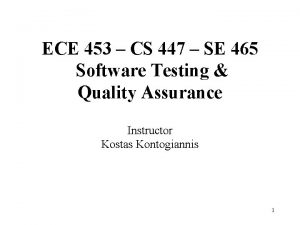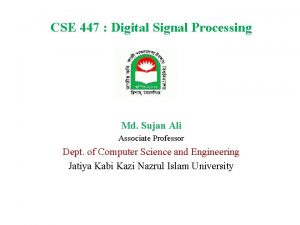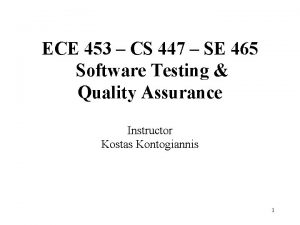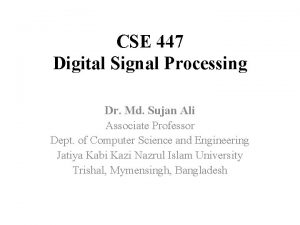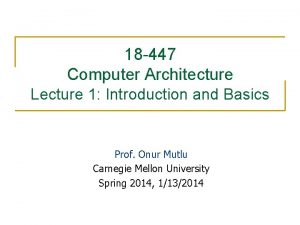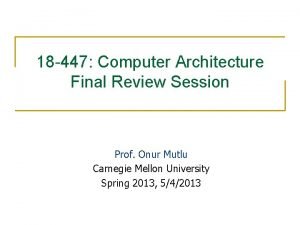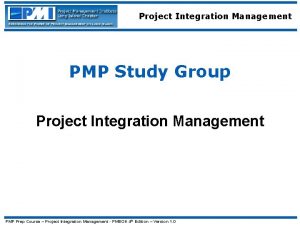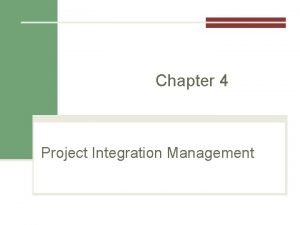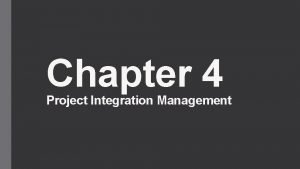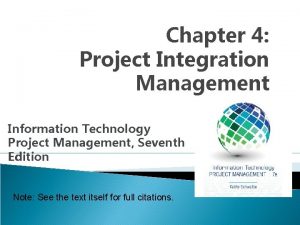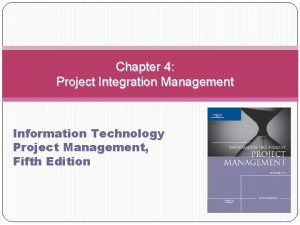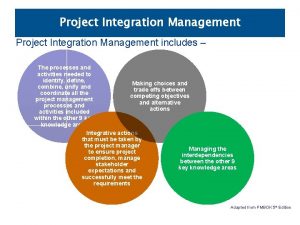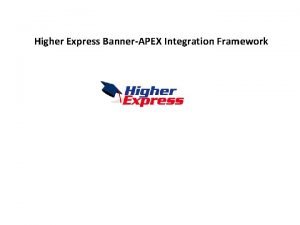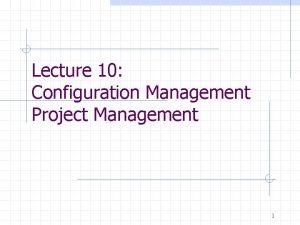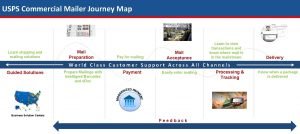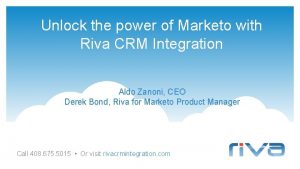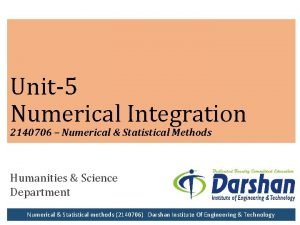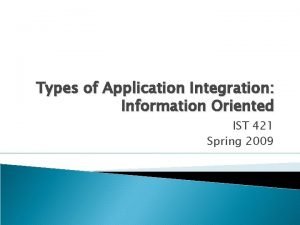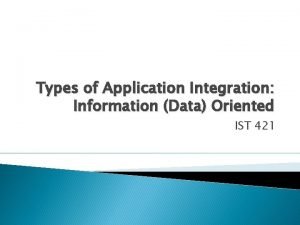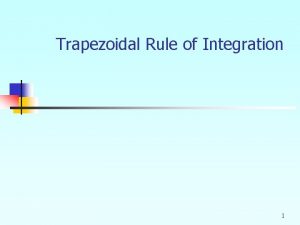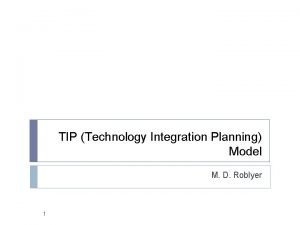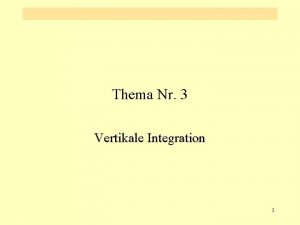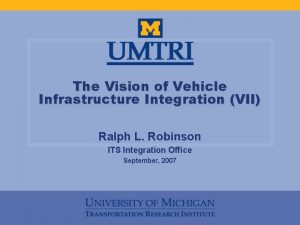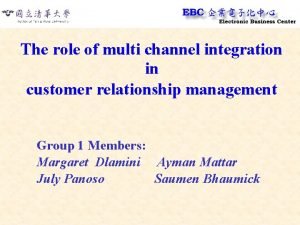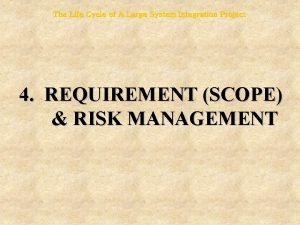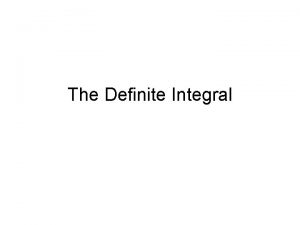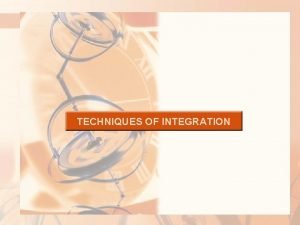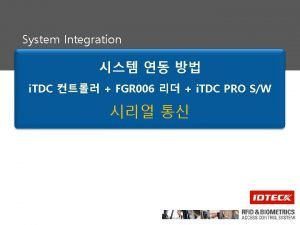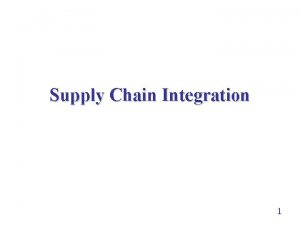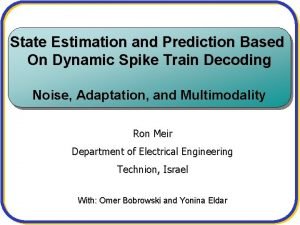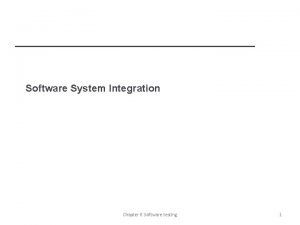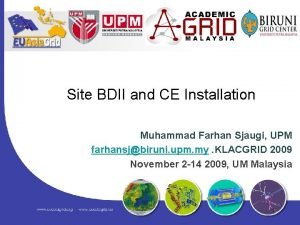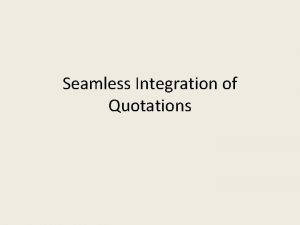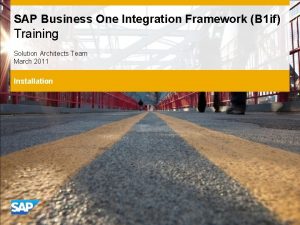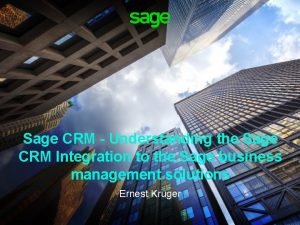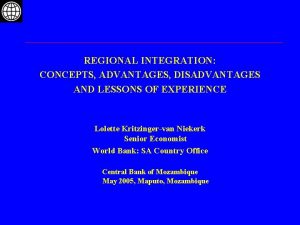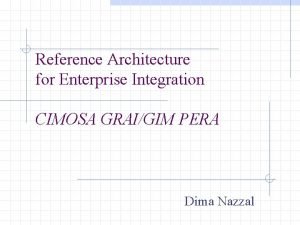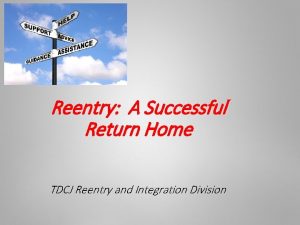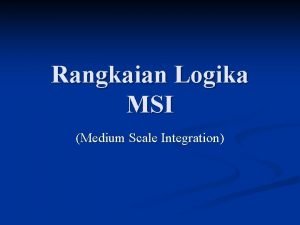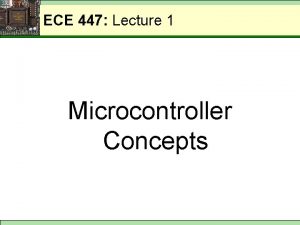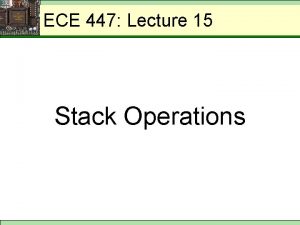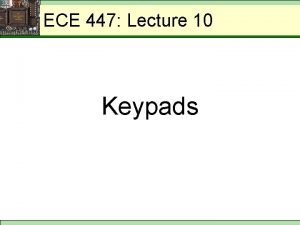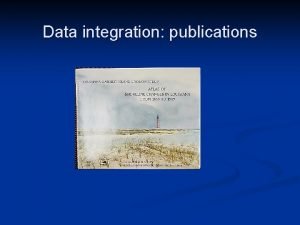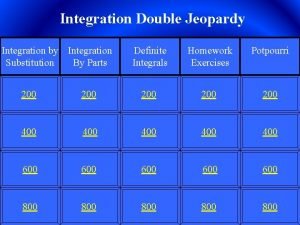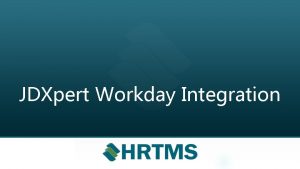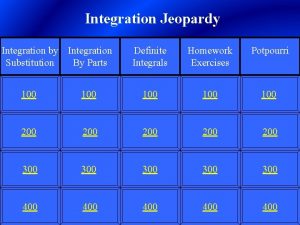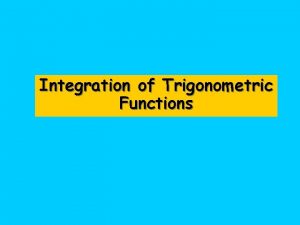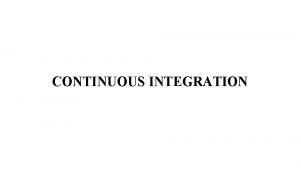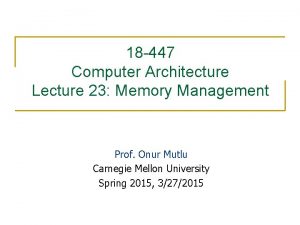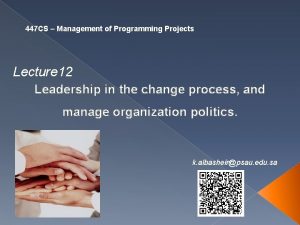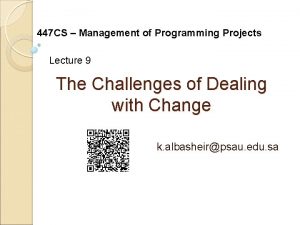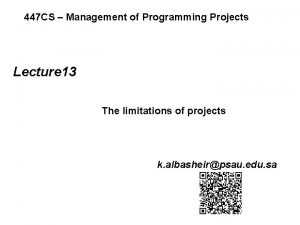Project Integration Management CE 447 PROJECT MANAGEMENT Project














































































- Slides: 78

Project Integration Management CE 447 - PROJECT MANAGEMENT Project Management 3 L-1

The Key to Overall Project Success: Good Project Integration Management • Project managers must coordinate all of the other knowledge areas throughout a project’s life cycle. • Many new project managers have trouble looking at the “big picture” and want to focus on too many details.

Integration Management • Includes processes to ensure that all the elements of a project are properly coordinated • Making tradeoffs among competing alternatives and objectives to meet stakeholder needs • Typically the most important knowledge area for the Project Manager

Project Integration Management Processes • • • Develop the project charter: Work with stakeholders to create the document that formally authorizes a project —the charter. Develop the preliminary project scope statement: Work with stakeholders, especially users of the project’s products, services, or results, to develop the high-level scope requirements and create a preliminary project scope statement. Develop the project management plan: Coordinate all planning efforts to create a consistent, coherent document—the project management plan.

Project Integration Management Processes (cont’d) • • Direct and manage project execution: Carry out the project management plan by performing the activities included in it. Monitor and control the project work: Oversee project work to meet the performance objectives of the project. Perform integrated change control: Coordinate changes that affect the project’s deliverables and organizational process assets. Close the project: Finalize all project activities to formally close the project.

Why Do We Manage Integration? • • • Manage change and communication Reduce project time and cost Involve stakeholders early and often Make results visible Identify problems/solutions early Use relevant experience as early as possible

Who Manages Integration? • Project Manager – Integrator for the project that executes processes • Team Members – Concentrate on completing tasks, activities, & work packages • Project Sponsor – Protect project from changes and losing resources

How Do We Manage Integration? Use the seven integration processes n Develop project charter n Develop project management plan n Direct and manage project execution n Monitor and control project work n Perform integrated change control n Close project or phase Project Charter Project Management Plan Direct & Manage Execution Monitor & Control Project Work Integrated Change Control Close Project or Phase

How Do We Manage Integration? Each process has: n Inputs n Tools and Techniques n Outputs Remember that inputs and outputs can feed more than one process! Project Charter Project Management Plan Direct & Manage Execution Monitor & Control Project Work Integrated Change Control Close Project or Phase

Project Integration Management Overview

Framework for Project Integration Management Focus on pulling everything together to reach project success! 11

• After deciding what project to work on, it is important to let the rest of the organization know. • A project charter is a document that formally recognizes the existence of a project and provides direction on the project’s objectives and management. • Key project stakeholders should sign a project charter to acknowledge agreement on the need and intent of the project; a signed charter is a key output of project integration management. 12 Project Charters

Project Charter Project Statement of Work Inputs Tools & Techniques q Project Selection Methods q Project Management Methodology Enterprise Environmental Factors Outputs Project Charter q Project Management Information System Contract q Expert Judgment Organizational Process Assets Project Charter Project Management Plan Direct & Manage Execution Monitor & Control Project Work Integrated Change Control Close Project or Phase

Preliminary Scope Statements • It is an important tool for preventing scope creep: • The tendency for project scope to keep getting bigger. • A good practice is to develop a preliminary or initial scope statement during project initiation and a more detailed scope statement as the project progresses. 14 • A scope statement is a document used to develop and confirm a common understanding of the project scope.

• Project objectives • Product or service requirements and characteristics • Project boundaries • Deliverables • Product acceptance criteria • Project assumptions and constraints • Organizational structure for the project • Initial list of defined risks • Summary of schedule milestones • Rough order of magnitude cost estimate • Configuration management requirements • Description of approval requirements 15 Contents of a Preliminary Scope Statement

Project Management Plans • Plans created in the other knowledge areas are subsidiary parts of the overall project management plan. 16 • A project management plan is a document used to coordinate all project planning documents and help guide a project’s execution and control.

Project Management Plan Inputs Preliminary Project Scope Statement Tools & Techniques q Project Management Methodology Project Management Processes q Project Management Information System Enterprise Environmental Factors Organizational Process Assets q Expert Judgment Project Charter Project Management Plan Direct & Manage Execution Monitor & Control Project Work Outputs Integrated Change Control Project Management Plan Close Project or Phase

Attributes of Project Plans • Just as projects are unique, so are project plans. • Dynamic • Flexible • Updated as changes occur • Plans should first and foremost guide project execution by helping the project manager lead the project team and assess project status. 18 • Plans should be:

Common Elements of a Project Management Plan • Description of how the project is organized. • Management and technical processes used on the project. • Work to be done, schedule, and budget information. 19 • Introduction or overview of the project.

Project Execution • Project execution involves managing and performing the work described in the project management plan. • The application area of the project directly affects project execution because the products of the project are produced during project execution. 20 • The majority of time and money is usually spent on execution.

Coordinating Planning and Execution 21 • Project planning and execution are intertwined and inseparable activities. • Those who will do the work should help to plan the work. • Project managers must solicit input from the team to develop realistic plans.

Direct & Manage Execution Inputs Project Management Plan Approved Corrective Actions Approved Preventive Actions Approved Change Requests Approved Defect Repair Tools & Techniques q Project Management Methodology q Project Management Information System Outputs Deliverables Requested Changes Implemented Change Requests Implemented Corrective Actions Implemented Preventive Actions Validated Defect Repair Implemented Defect Repair Administrative Closure Procedure Work Performance Information Project Charter Project Management Plan Direct & Manage Execution Monitor & Control Project Work Integrated Change Control Close Project or Phase

Leadership and a Supportive Culture • Providing guidelines and templates. • Tracking performance based on plans. • Project managers may still need to break the rules to meet project goals, and senior managers must support those actions. 23 • Project managers must lead by example to demonstrate the importance of creating and then following good project plans. • Organizational culture can help project execution by:

Important Skills for Project Execution 24 • General management skills such as leadership, communication, and political skills. • Product, business, and application area skills and knowledge. • Use of specialized tools and techniques.

Project Execution Tools and Techniques • Project management information systems: Hundreds of project management software products are available on the market today, and many organizations are moving toward powerful enterprise project management systems that are accessible via the Internet. 25 • Project management methodology: Many experienced project managers believe the most effective way to improve project management is to follow a methodology that describes not only what to do in managing a project, but how to do it.

Monitoring and Controlling Project Work • Monitoring project work includes collecting, measuring, and disseminating performance information. • Two important outputs of monitoring and controlling project work include recommended corrective and preventive actions. 26 • Changes are inevitable on most projects, so it’s important to develop and follow a process to monitor and control changes.

Monitor & Control Project Work Tools & Techniques Inputs Project Management Plan q Project Management Methodology Forecasts q Earned Value Management Rejected Change Requests Recommended Corrective Actions Recommended Preventive Actions q Project Management Information System Work Performance Information Project Charter Outputs Recommended Defect Repair q Expert Judgment Requested Changes Project Management Plan Direct & Manage Execution Monitor & Control Project Work Integrated Change Control Close Project or Phase

Integrated Change Control • • Influence the factors that create changes to ensure that changes are beneficial. • Determine that a change has occurred. • Manage actual changes as they occur. A baseline is the approved project management plan plus approved changes. 28 Three main objectives are: •

Change Control System • Describes who is authorized to make changes and how to make them. 29 • A formal, documented process that describes when and how official project documents and work may be changed.

Change Control Boards (CCBs) • CCBs provide guidelines for preparing change requests, evaluate change requests, and manage the implementation of approved changes. • CCBs include stakeholders from the entire organization. 30 • A formal group of people responsible for approving or rejecting changes on a project.

Configuration Management • Involves identifying and controlling the functional and physical design characteristics of products and their support documentation. • Configuration management specialists identify and document configuration requirements, control changes, record and report changes, and audit the products to verify conformance to requirements. 31 • Ensures that the descriptions of the project’s products are correct and complete.

Integrated Change Control Tools & Techniques Outputs Inputs Project Management Plan Requested Changes Work Performance Information Recommended Preventive Actions Recommended Corrective Actions q Project Management Methodology Approved Change Requests q Project Management Information System Project Management Plan Updates q Expert Judgment Rejected Change Requests Project Scope Statement Updates Approved Corrective Actions Approved Preventive Actions Recommended Defect Repair Approved Defect Repair Deliverables Validated Defect Repair Deliverables Project Charter Project Management Plan Direct & Manage Execution Monitor & Control Project Work Integrated Change Control Close Project or Phase

Closing Projects • Main outputs include: • Administrative closure procedures. • Contract closure procedures. • Final products, services, or results. • Organizational process asset updates. 33 • To close a project, you must finalize all activities and transfer the completed or cancelled work to the appropriate people.

Close Project or Phase Inputs Project Management Plan Contract Documentation Tools & Techniques q Project Management Methodology Outputs Administrative Closure Procedure Contract Closure Procedure Enterprise Environmental Factors q Project Management Information System Final Product, Service, or Result Organizational Process Assets q Expert Judgment Organizational Process assets Updates Work Performance Information Deliverables Project Charter Project Management Plan Direct & Manage Execution Monitor & Control Project Work Integrated Change Control Close Project or Phase

PM Responsibility for Change • Influence factors that affect change • Ensure change is beneficial • Determine if a change has occurred • Determine if a change is needed • Look for alternatives to change • Minimize negative impact from change • Notify Stakeholders impacted by change • Managing those changes that do occur according to project plan

Responsibility • Responsibility: The duties, assignments, and accountability for results associated with a designated position in the organization.

Accountability Being answerable to one's superior in an organization for the exercise of one's authority and the performance of one's duties.

Authority The legitimate power given to a person in an organization to use resources to reach an objective and to exercise discipline.

Definitions • Lessons Learned – Document that identifies what was done right, wrong, and how to improve in the future • Baseline – The original project plan with approved changes

- Introduction - Risk identification - Risk projection (estimation) - Risk mitigation, monitoring, and management CE 447 - PROJECT MANAGEMENT Project Risk management 3 L-1

• Risk: any condition or event whose occurrence is not certain but which can cause the project to FAIL • Aim of risk management: minimize the effect of risks on a project 41

Risk ”If you don’t actively attack risks, they will actively attack you. ” — Tom Gilb Project risks • budget, schedule, resources, size, personnel, morale. . . Technical risks • implementation technology, verification, maintenance. . . Business risks • market, sales, management, commitment. . .

Risk Management … Management must: • identify risks as early as possible • assess whether risks are acceptable • take appropriate action to mitigate and manage risks • e. g. , training, prototyping, iteration, . . . • monitor risks throughout the project

Risk Management Techniques Risk Items Risk Management Techniques Personnel shortfalls Staffing with top talent; team building; cross-training; pre-scheduling key people Unrealistic schedules and budgets Detailed multi-source cost & schedule estimation; incremental development; reuse; re-scoping

Risk Management Techniques … Risk Items Continuing stream of requirements changes Real time performance shortfalls Straining computer science capabilities Risk Management Techniques High change threshold; information hiding; incremental development Simulation; benchmarking; modeling; prototyping; instrumentation; tuning Technical analysis; cost-benefit analysis; prototyping; reference checking

Risk Management Tasks Risk Management Activities 46

Definition of Risk • A risk is a potential problem – it might happen and it might not • Conceptual definition of risk • Risk concerns future happenings • Risk involves change in mind, opinion, actions, places, etc. • Risk involves choice and the uncertainty that choice entails • Two characteristics of risk • Uncertainty – the risk may or may not happen, that is, there are no 100% risks (those, instead, are called constraints) • Loss – the risk becomes a reality and unwanted consequences or losses occur 47

Risk Categorization – Approach #1 • Project risks • They threaten the project plan • If they become real, it is likely that the project schedule will slip and that costs will increase • Technical risks • They threaten the quality and timeliness of the project • If they become real, implementation may become difficult or impossible • Business risks • They threaten the viability of the project • If they become real, they jeopardize the project or the product 48 (More on next slide)

Risk Categorization – Approach #1 (continued) • Sub-categories of Business risks • Market risk – building an excellent product or system that no one really wants • Strategic risk – building a product that no longer fits into the overall business strategy for the company • Sales risk – building a product that the sales force doesn't understand how to sell • Management risk – losing the support of senior management due to a change in focus or a change in people • Budget risk – losing budgetary or personnel commitment 49

Risk Categorization – Approach #2 • Known risks • Those risks that can be uncovered after careful evaluation of the project plan, the business and technical environment in which the project is being developed, and other reliable information sources (e. g. , unrealistic delivery date) • Predictable risks • Those risks that are extrapolated from past project experience (e. g. , past turnover) • Unpredictable risks • Those risks that can and do occur, but are extremely difficult to identify in advance 50

Reactive vs. Proactive Risk Strategies • Reactive risk strategies • "Don't worry, I'll think of something” • Nothing is done about risks until something goes wrong • The team then flies into action in an attempt to correct the problem rapidly (fire fighting) • Crisis management is the choice of management techniques • Proactive risk strategies • Steps for risk management are followed • Primary objective is to avoid risk and to have a contingency plan in place to handle unavoidable risks in a controlled and effective manner 51

Steps for Risk Management 1) 2) 3) Identify possible risks; recognize what can go wrong Analyze each risk to estimate the probability that it will occur and the impact (i. e. , damage) that it will do if it does occur Rank the risks by probability and impact (Prioritize) - Impact may be negligible, marginal, critical, and catastrophic 4) Develop a contingency plan to manage those risks having high probability and high impact 52

Risk Identification

• Risk identification is a systematic attempt to specify threats to the project plan • By identifying known and predictable risks, the project manager takes a first step toward avoiding them when possible and controlling them when necessary 54

Risk Item Checklist • Used as one way to identify risks • Focuses on known and predictable risks in specific subcategories • Can be organized in several ways • A list of characteristics relevant to each risk subcategory • Questionnaire that leads to an estimate on the impact of each risk • A list containing a set of risk component and drivers and their probability of occurrence 55

Known and Predictable Risk Categories • Product size – risks associated with overall size of the project • Business impact – risks associated with constraints imposed by management or the marketplace • Customer characteristics – risks associated with sophistication of the customer and the developer's ability to communicate with the customer in a timely manner • Project definition – risks associated with the degree to which the project has been defined • Development environment – risks associated with availability and quality of the tools to be used to build the project • Technology to be built – risks associated with complexity of the system to be built and the "newness" of the technology in the system • Staff size and experience – risks associated with overall technical and project experience of the project team who will do the work 56

Questionnaire on Project Risk (Questions are ordered by their relative importance to project success) 1) 2) 3) 4) 5) 6) Have top project managers formally committed to support the project? Are clients enthusiastically committed to the project? Are requirements fully understood by the project team? Has client been involved fully in the definition of requirements? Do clients have realistic expectations? Is the project scope stable? 57 (More on next slide)

Questionnaire on Project Risk (continued) 7) 8) 9) 10) 11) Does the project team have the right mix of skills? Are project requirements stable? Does the project team have experience with the technology to be implemented? Is the number of people on the project team adequate to do the job? Do all clients constituencies agree on the importance of the project and on the requirements for the project to be realized? 58

Risk Prioritization • • The number of risks might be large Must prioritize them to focus attention on the “high risk” areas For prioritization, impact of each risk must be understood In addition, probability of the risk occurring should also be understood 59

Risk Prioritization. . . • • Risk exposure (RE) = probability of risk occurring * risk impact RE is the expected value of loss for a risk Prioritization can be done based on risk exposure value Plans can be made to handle high RE risks 60

A Simple approach to Risk Prioritization • • • Classify risk occurrence probabilities as: Low, Medium, High Classify risk impact as: Low, Medium, High Identify those that are HH, or HM/MH Focus on these for risk mitigation Will work for most small and medium sized projects 61

Risk Components and Drivers • The project manager identifies the risk drivers that affect the following risk components • Performance risk - the degree of uncertainty that the product will meet its requirements and be fit for its intended use • Cost risk - the degree of uncertainty that the project budget will be maintained • Support risk - the degree of uncertainty that the resultant product will be easy to correct, adapt, and enhance • Schedule risk - the degree of uncertainty that the project schedule will be maintained and that the product will be delivered on time • The impact of each risk driver on the risk component is divided into one of four impact levels • Negligible, marginal, critical, and catastrophic • Risk drivers can be assessed as impossible, improbable, and frequent 62

Risk Projection (Estimation)

Background • Risk projection (or estimation) attempts to rate each risk in two ways • The probability that the risk is real • The consequence of the problems associated with the risk, should it occur • The project planner, managers, and technical staff perform four risk projection steps (see in next slide) • The intent of these steps is to consider risks in a manner that leads to prioritization 64

Risk Projection/Estimation Steps 1) 2) 3) 4) Establish a scale that reflects the perceived likelihood of a risk (e. g. , 1 -low, 10 -high) Delineate the consequences of the risk Estimate the impact of the risk on the project and product Note the overall accuracy of the risk projection so that there will be no misunderstandings 65

Risk Projection/Estimation Steps • FMEA – Failure Mode and Effect Analysis Threat Severity, S Likelihood, L Ability to Detect , D 1. effect(1 -10) priority certainty(1 -10) RPN risk number 1. A 2. B 3. C 66

Contents of a Risk Table • A risk table provides a project manager with a simple technique for risk projection • It consists of five columns • • • Risk Summary – short description of the risk Risk Category – one of seven risk categories (project, technical, business) Probability – estimation of risk occurrence based on group input Impact – (1) catastrophic (2) critical (3) marginal (4) negligible RMMM – Pointer to a paragraph in the Risk Mitigation, Monitoring, and Management Plan Risk Summary Risk Category Probability Impact (1 -4) RMMM 67 (More on next slide)

Developing a Risk Table • List all risks in the first column (by way of the help of the risk item checklists) • Mark the category of each risk • Estimate the probability of each risk occurring • Assess the impact of each risk based on an averaging of the four risk components to determine an overall impact value (See next slide) • Sort the rows by probability and impact in descending order • Draw a horizontal cutoff line in the table that indicates the risks that will be given further attention 68

Assessing Risk Impact • Three factors affect the consequences that are likely if a risk does occur • Its nature – This indicates the problems that are likely if the risk occurs • Its scope – This combines the severity of the risk (how serious was it) with its overall distribution (how much was affected) • Its timing – This considers when and for how long the impact will be felt • The overall risk exposure formula is RE = P x C • P = the probability of occurrence for a risk • C = the cost to the project should the risk actually occur • Example • P = 80% probability that 18 of 60 software components will have to be developed • C = Total cost of developing 18 components is $25, 000 • RE =. 80 x $25, 000 = $20, 000 69

Risk Mitigation, Monitoring, and Management

Risk Control • Can the risk be avoided? • E. g. if new hardware is a risk, it can be avoided by working with proven hardware • For others, risk mitigation steps need to be planned and executed • Actions taken in the project such that if the risk materializes, its impact is minimal • Involves extra cost 71

Background • An effective strategy for dealing with risk must consider three issues (Note: these are not mutually exclusive) • Risk mitigation (i. e. , avoidance) • Risk monitoring • Risk management and contingency planning • Risk mitigation (avoidance) is the primary strategy and is achieved through a plan • Example: Risk of high staff turnover 72 (More on next slide)

Background (continued) Strategy for Reducing Staff Turnover q Meet with current staff to determine causes for turnover (e. g. , poor working conditions, low pay, competitive job market) q Mitigate those causes that are under our control before the project starts q Once the project commences, assume turnover will occur and develop techniques to ensure continuity when people leave q Organize project teams so that information about each development activity is widely dispersed q Define documentation standards and establish mechanisms to ensure that documents are developed in a timely manner q Conduct peer reviews of all work (so that more than one person is "up to speed") q Assign a backup staff member for every critical technologist 73

Background (continued) • During risk monitoring, the project manager monitors factors that may provide an indication of whether a risk is becoming more or less likely • Risk management and contingency planning assume that mitigation efforts have failed and that the risk has become a reality • RMMM steps incur additional project cost • Large projects may have identified 30 – 40 risks • Risk is not limited to the software project itself • Risks can occur after the software has been delivered to the user 74 (More on next slide)

Background (continued) • safety and hazard analysis • These are product quality assurance activities that focus on the identification and assessment of potential hazards that may affect product negatively and cause an entire system to fail • If hazards can be identified early in the product process, product design features can be specified that will either eliminate or control potential hazards 75

The RMMM Plan • The RMMM plan may be a part of the product development plan or may be a separate document • Once RMMM has been documented and the project has begun, the risk mitigation, and monitoring steps begin • Risk mitigation is a problem avoidance activity • Risk monitoring is a project tracking activity • Risk monitoring has three objectives • To assess whether predicted risks do, in fact, occur • To ensure that risk aversion steps defined for the risk are being properly applied • To collect information that can be used for future risk analysis • The findings from risk monitoring may allow the project manager to ascertain what risks caused which problems throughout the project 76

Seven Principles of Risk Management • Maintain a global perspective • View risks within the context of a system and the business problem that is is intended to solve • Take a forward-looking view • Think about risks that may arise in the future; establish contingency plans • Encourage open communication • Encourage all stakeholders and users to point out risks at any time • Integrate risk management • Integrate the consideration of risk into the product process • Emphasize a continuous process of risk management • Modify identified risks as more becomes known and add new risks as better insight is achieved • Develop a shared product vision • A shared vision by all stakeholders facilitates better risk identification and assessment • Encourage teamwork when managing risk • Pool the skills and experience of all stakeholders when conducting risk management activities 77

Summary • Whenever much is riding on a project, common sense dictates risk analysis • Yet, most project managers do it informally and superficially • However, the time spent in risk management results in • Less upheaval during the project • A greater ability to track and control a project • The confidence that comes with planning for problems before they occur • Risk management can absorb a significant amount of the project planning effort…but the effort is worth it 78
 Seguro estou nao tenho temor
Seguro estou nao tenho temor Msz 447
Msz 447 Cs 447
Cs 447 Dr sujan ali
Dr sujan ali 699 en yakın yüzlüğe yuvarlama
699 en yakın yüzlüğe yuvarlama 447 bc
447 bc Cs 447
Cs 447 Gcf of 12 and 24
Gcf of 12 and 24 What is z?
What is z? 18-447
18-447 Fces
Fces Define project integration management
Define project integration management Forward integration and backward integration
Forward integration and backward integration Vertical diversification example
Vertical diversification example Simultaneous integration meaning
Simultaneous integration meaning Project integration management definition
Project integration management definition Project integration management example
Project integration management example Project integration management diagram
Project integration management diagram Directing and managing project execution
Directing and managing project execution Project integration management example
Project integration management example Six processes of project integration management
Six processes of project integration management Traditional vs modern project management
Traditional vs modern project management Oracle project integration framework
Oracle project integration framework Berapa proses integration management
Berapa proses integration management The role of project management in achieving project success
The role of project management in achieving project success Process discriminants in software project management
Process discriminants in software project management Cost duration graph
Cost duration graph Modern project management began with what project
Modern project management began with what project Project evaluation in software project management
Project evaluation in software project management Types of project audit in project management
Types of project audit in project management Ms project agile template
Ms project agile template Types of terminations
Types of terminations Asset management vs project management
Asset management vs project management Configuration management in project management
Configuration management in project management Basic principles of cost management
Basic principles of cost management Configuration management in software project management
Configuration management in software project management Scientific management
Scientific management Top management middle management first line management
Top management middle management first line management Top management middle management first line management
Top management middle management first line management Direct quote example
Direct quote example Integration symbol copy
Integration symbol copy Sitecore content hub development
Sitecore content hub development Voice data integration
Voice data integration Rockefeller vertical or horizontal
Rockefeller vertical or horizontal Docmail access dimensions integration
Docmail access dimensions integration Riva crm integration reviews
Riva crm integration reviews Weddle's rule
Weddle's rule Information-oriented application integration
Information-oriented application integration Information-oriented examples
Information-oriented examples One segment trapezoidal rule
One segment trapezoidal rule Technology integration planning (tip)
Technology integration planning (tip) Vertikale integration
Vertikale integration Vehicle infrastructure integration
Vehicle infrastructure integration Multi channel integration process
Multi channel integration process Andrew carnegie vertical integration
Andrew carnegie vertical integration Principle of integration
Principle of integration System integration lifecycle
System integration lifecycle Webmetrics stats
Webmetrics stats Area under the curve integration
Area under the curve integration Bernoulli brothers
Bernoulli brothers Rules for integration
Rules for integration Tdc systems integration
Tdc systems integration Walmart horizontal integration
Walmart horizontal integration Transnational strategy vs global strategy
Transnational strategy vs global strategy Multisensory integration examples
Multisensory integration examples System integration checklist
System integration checklist Systems integration plan
Systems integration plan Msi medium scale integration
Msi medium scale integration Metapack microsoft dynamics nav integration
Metapack microsoft dynamics nav integration Lateral aperture
Lateral aperture Quote integration methods
Quote integration methods Business one integration framework
Business one integration framework Moodle salesforce integration
Moodle salesforce integration Communicator sage crm integration
Communicator sage crm integration Disadvantages of regional integration
Disadvantages of regional integration Enterprise integration reference architecture
Enterprise integration reference architecture Tdcj reentry and integration division
Tdcj reentry and integration division Ic msi
Ic msi Quote integration mla
Quote integration mla


